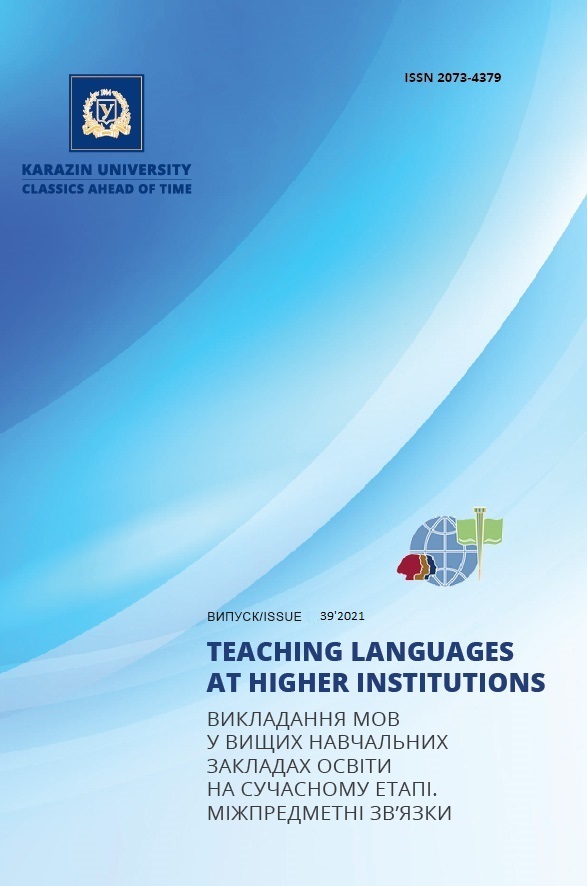Feminitives in teaching Ukrainian as a foreign language
Abstract
The article is devoted to the development of a methodology for teaching feminitives of the Ukrainian language to foreign students. The authors analyze the structure of modern feminitives in the Ukrainian language, select units for training, and propose exercises to consolidate knowledge of the learned material. The problem of the formation of feminitives in different languages is relevant in connection with democratic social processes. Another area of study of feminitives concerns their structural features. The problem of the formation and functioning of feminitives is closely related to the phenomenon of linguistic political correctness in the use of gender-labeled words (especially the names of professions), the problems of word formation, and intercultural differences in the use of gender-neutral and gender-labeled words. The relevance of the work is due to the lack of development of a methodology for teaching feminitives in Ukrainian as a foreign language. Vocabulary plays an essential role in teaching the Ukrainian language to foreign students. The systematic accumulation and expansion of vocabulary are one of the main tasks during language learning. The general derivational tendencies of the development of feminitives of the Ukrainian language are: increasing the productivity of the suffixal way of the derivation of feminitives; updating and expanding the word-formation base of feminitives, especially through numerous borrowings; archaization of some derivational types of feminitives; activation of previously unproductive types; the spread of feminitives in the professional sphere to designate women by position, specialization, by type, place of activity, success, achievements, etc. Modern changes in society necessitate a more attentive approach to the selection and presentation of vocabulary and educational texts to a foreign audience. The language is constantly changing, which means that constant updating of educational materials is required as an important tool in the language environment for foreigners to familiarize themselves with the picture of the world of its native speakers. In this sense, the role of the authors of manuals and teachers of Ukrainian as a foreign language has been increasing, as they introduce foreigners to the modern Ukrainian picture of the world through the prism of their own perception.
Downloads
References
Brus, M.P. (2019). Feminityvy v ukrayinskij movi: geneza, evolyuciya, funkcionuvannya [Feminitives in the Ukrainian language: genesis, evolution, functioning]. Ivano-Frankivsk: Vasil Stefanyk Precarpathian National University [in Ukrainian].
Kozachyshyna, O.L. and Mosijchuk, A.V. (2020). Feminitives in Modern Ukrainian Newspaper Discourse. Science and Education a New Dimension. Philology, VIII (72), Issue: 241. Nov., pр. 26–29. [Available at: http://seanewdim.com/uploads/3/4/5/1/34511564/httpsdoi.org10.31174send-ph2020-241viii72-05.pdf [Accessed 20 Aug. 2021] [in Ukrainian]. DOI: https://doi.org/10.31174send-ph2020-241viii72-05.
Denisova, A.A. (ed.) (2002). Slovar gendernyh terminov [Jelektronnyj resurs] [Glossary of gender terms]. Regional public organisation “Vostok-Zapad: Zhenskie Innovacionnye Proekty”. Moscow: Informacija XXI vek. Available at: http://www.owl.ru/gender/thesaurus.htm [Accessed 24 Aug. 2021] [in Russian].
Feminityvy [Wikipedia article on femininities]. Available at: https://uk.wikipedia.org/wiki/%D0%A4%D0%B5%D0%BC%D1%96%D0%BD%D1%96%D1%82%D0%B8%D0%B2%D0%B8 [Accessed 15 Aug. 2021] [in Ukrainian].
Sheremet, A. (2020). Gender-specific job titles in the ukrainians’ worldview (based in the materials of the language of web-based media). Aktualni pytannya gumanitarnyh nauk [Topical issues of the humanities], 27, 5, pp. 65–70 [in Ukrainian]. DOI: https://doi.org/10.24919/2308-4863.5/27.204489.

